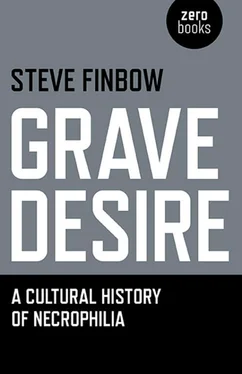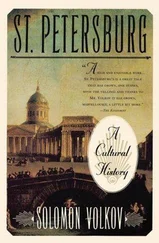In 1931, Carl von Cosel (Carl Tanzer), a radiologist and amateur inventor in his mid-50s, took an obsessive interest in 22-year-old Maria Elena Milagro de Hoyos, a tuberculosis patient at the sanitarium in which he worked in Key West, Florida. After falling in love with the attractive woman, he bought her jewellery and other gifts, and used his medical knowledge to try to cure her, but Elena succumbed to her illness and died in October of that year. Distraught, von Cosel had a mausoleum constructed in Key West Cemetery in which—with the consent of her family—he preserved her body in formaldehyde. He would visit her and talk to her, installing a telephone so he could speak to her at all times. But even that was not enough—it did not dampen his obsession or his desire. Two years after he first fell in love, he disentombed the embalmed body and took it home on a pushcart. ‘Decay had set in in a most disheartening manner. Only with the greatest care was I able to peel the pieces of textile from the body; this took hours. We then lifted the body out of the coffin and laid it on a table with a clean sheet. Having sprayed the body all over again, I now proceeded to sponge her, face with a specially prepared solution and also her hands and feet. With dismay I discovered that in view of the damage already done much more cleaning was required than could be done in the one night I had the morgue at my disposal.’ [65] Karl Tanzler von Cosel, ‘The Secret of Elena’s Tomb,’ Fantastic Adventures, September 1947, (Chicago, 1947). This ghosted novella followed ‘The Mad Scientist’ a short story by Psycho author Robert Bloch. http://www.unz.org/Pub/FantasticAdventures-1947sep-00008
He rigged her bones with piano wire and coat hangers, inserted glass eyes into the orbital sockets when her real eyes putrefied, smothered her with wax and make-up, replaced some of her rotting skin with silk, had a wig fashioned, eviscerated the body and filled it with rags like a Guy Fawkes dummy, and dressed her (it) as a bride. To enable sexual congress with Elena, he intruded a paper tube into what was once her vagina. ‘Long I lay thus, holding her closely to me, the living and the dead united in love. The sweetness, of this was divine. Never had I dreamt that she had preserved so sweet and intense a love for me after being in the grave so long. Was it possible? I could hardly grasp or believe it, but here was the undeniable evidence. Life and death united together, eye to eye.’ [66] ‘The Secret of Elena’s Tomb’.
As David Foster Wallace has pointed out in Both Flesh And Not, ‘the unpleasant is perfectly OK, just so long as it rivets.’ [67] David Foster Wallace, Both Flesh and Not, (London, 2012), p. 46.
Von Cosel lived with his corpse bride for seven years before Elena’s sister—acting on information—discovered the body in his house and reported him to the police. A local rest home put his lover’s body on public display. Von Cosel underwent psychiatric tests in prison while awaiting trial but the case never made it to court. Authorities reburied the corpse in an unmarked grave. Von Cosel responded by making a life-size doll of Elena, incorporating her death mask, and lived with it until he died in 1952. Von Cosel’s necrophilia attracted attention in the news and the arts, and horror writers used his actions as building blocks for shocking tales of tomb raiding and lust, murder and eroticism, madness and pornography. [68] See Tom Swicegood, Von Cosel, (Lincoln, 2003), Ben Harrison, Undying love: the true story of a passion that defied death (New York, 2001).
Von Cosel’s necrophilia centred on one corpse on/in whom/which he consummated his possessive love regardless of societal norms. He transgressed any repressive balance, any primary principles. ‘I had begun feeding her body orally with nourishing fluids regularly every day.’ [69] ‘The Secret of Elena’s Tomb’.
The object transference of his libido from dying woman to dead body enacts the ‘limitlessness in desire,’ [70] Slavoj Žižek, Violence (New York, 2008), p. 63.
where ‘urges of the flesh pass all bounds in the absence of controlling will.’ [71] George Bataille, Erotism: Death & Sensuality, trans. Mary Dalwood (San Francisco, 1986), p. 92.
The id (the duality of the libido and the death drive) overwhelms the super-ego. As Freud has it, ‘Each one of us goes a bit too far, either here or there, in transgressing the boundaries that we have drawn up in our sexual lives. The perversions are neither bestialities nor degeneracies in the dramatic sense of that word. They are the development of germs that are all contained within the undifferentiated sexual predisposition of a child, the suppression of which or their application to higher, asexual goals—their sublimation—is destined to supply the forces behind a large number of our cultural achievements. So if someone has become coarse and manifestly perverse, it would be more accurate to say that he has remained so, that he represents a stage of an arrested development.’ [72] Sigmund Freud, The Psychology of Love, trans. Shaun Whiteside (London, 2006), p. 39.
If von Cosel’s obsessive love became necrophilia, then the following case is an example of proximal desire for the dead. Women are not adverse to corpse love. Karen Greenlee, who worked in the funeral business, had an overwhelming desire for men in their twenties and thirties—dead men in their twenties and thirties. One day in 1979, driving a hearse from Sacramento Memorial Lawn Mortuary to a nearby cemetery containing the coffin and body of John Mercure, a 33-year-old male, Greenlee made a detour, taking the corpse back to her house to act out her codeine-fuelled sexual fantasies. After two days, the authorities tracked her down and arrested her. In the dead man’s coffin, police found a four-page note revealing her necro-erotic exploits with between 20 and 40 dead bodies. Remorseful, she questioned her motives, asking if her fear of love had turned into a love of death, calling herself a ‘morgue rat,’ and categorizing her desire as ‘a rathole, perhaps my grave.’ [73] Jim Morton, ‘The Unrepentant Necrophile: An Interview with Karen Greenlee,’ Apocalypse culture: volume 1, ed., Adam Parfrey (Portland, 1990), p. 28.
As California had no law against necrophilia until 10 September 2004, the court fined Greenlee $225 and jailed her for eleven days for car theft and misdemeanours pertaining to the illegal removal of a corpse. On her release, as part of the terms of her two-year probation, Greenlee agreed to undergo psychiatric assessments. The corpses satisfied her sexual need not through penetration but by clitoral stimulation and frottage, while the attendant cold touch and embalming-fluid aroma of the dead body gratified the necromantic ritual of burial and the stimulant rush of taboo. She would arrive at night, use her keys to the funeral home, and spend hours riding the bodies cowgirl style, the dead men would have their own orgasm, spilling a little blood from their mouths. She would even attend the funerals, her gasps and cries erotic simulations of grief. From an early age, she had been attracted to death; she had her own pet cemetery, and became obsessed with the local funeral home, wandering its corridors, stealing into its chapels. When bodies were not available in her place of work, she broke into other funeral homes, sometimes into tombs—as long as the men were between 20 and 40 and were not fat, she felt attracted to them, whether or not they had died in car crashes, had been shot, or had self-asphyxiated in an auto-erotic accident.
The first scene of Nekromantik 2 shows Robert Schmadtke from Nekromantik [74] Nekromantik (1987) and Nekromantik 2 (1991) directed by Jörg Buttgereit.
killing himself. A woman, Monika, disinters his body and takes it home. She attempts to have sex with Rob’s body but cannot reach orgasm. Monika then meets up with a man called Mark to watch a movie—which shows a very Bataillean scene of naked people eating boiled eggs. Attracted to Mark, Monika now wants to get rid of Rob’s corpse, so she cuts it up and keeps a few mementoes—his penis and head. But sex with the living Mark does not satisfy her and Mark starts to have doubts about the relationship after finding Rob’s castrated penis in the refrigerator. Returning to the apartment with a pizza to witness Monika and her friends watching a documentary about an autopsy on a seal, Mark finds the film disgusting. The couple argue and Mark leaves. After a telephone conversation, they get together and have sex, Monika on top trying to prevent Mark moving in order to simulate her necrosexual fantasies. Then, unsatisfied by the role-playing, Monika grabs a saw she has hidden under the bed and thrusts it into Mark’s neck. As he is about to be decapitated, she takes out a cock ring and places it on his still erect penis. Monika then puts Mark’s decapitated head on Rob’s corpse’s shoulders. ‘At last, one day at six, when the oblique sunshine was directly lighting the bathroom, a half sucked egg was suddenly invaded by the water, and after filling up with a bizarre noise, it was shipwrecked before our very eyes. This incident was so extraordinarily meaningful to Simone that her body tautened and she had a long climax, virtually drinking my left eye between her lips. Then, without leaving the eye, which was sucked as obstinately as a breast, she sat down, wrenching my head toward her on the seat, and she pissed noisily on the bobbing eggs with total vigor and satisfaction.’ [75] Georges Bataille, Story of the Eye (London, 2001), p. 34.
Читать дальше












